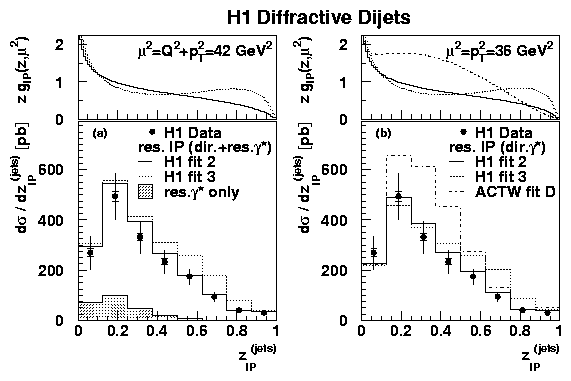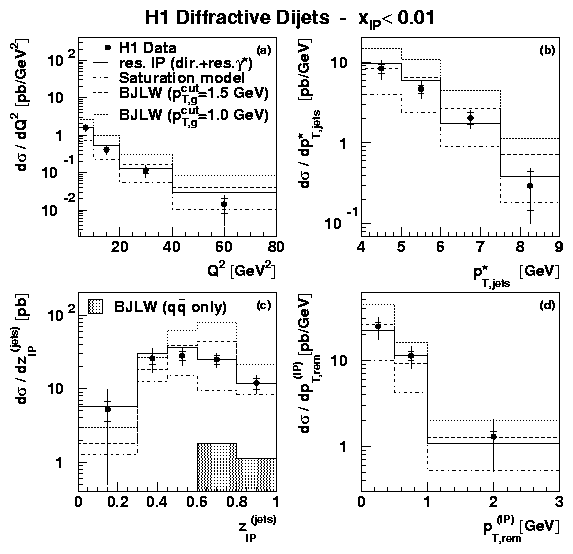Diffractive Jet Production in Deep-Inelastic e+p Collisions
at HERA
|
Diffractive scattering processes have been the subject of
intensive research in the H1 experiment at the ep collider HERA.
In Deep-Inelastic Scattering (DIS), a virtual
photon probes the quarks and gluons of the proton. Approximately 10% of the DIS
events are diffractive. In this case,
the proton remains intact, losing only a small fraction xIP
of its momentum during the interaction. In addition,
a complex hadronic system X is produced.
Diffractive interactions have been interpreted as being due to the
exchange of a net colour-singlet state
between the colliding proton and the virtual photon.
Historically, this so-called pomeron was assumed to be
dominated by gluons. Its exact partonic structure however remained unclear.
It was a breakthrough for diffraction when it became possible at HERA to
study the QCD structure of the colourless exchange.
The total cross section for diffractive DIS, presented in a
previous paper in the form of a structure function
F2D(3), has led to the extraction of diffractive
parton distributions, i.e. the composition of the colour singlet state
in terms of
quarks and gluons. Whilst the F2D(3) data yield
tight constraints on the quark content of the colourless exchange,
the gluon distribution is rather poorly known.
In this analysis, we focus on the subset of diffractive events for which
the system X contains two or more high transverse momentum jets. If the
diffractive exchange is indeed dominated by gluons,
then these events are expected to arise
dominantly from the Boson-Gluon-Fusion (BGF) process
(gamma* g --> q qbar). The dijet data are thus highly sensitive to
the gluon structure of the colourless exchange.
Compared with
previous H1 measurements of this process, the luminosity is
increased by an order of magnitude (L=18 pb-1) and the kinematic coverage is extended
(Q2>4 GeV2; pT,Jet>4 GeV).
This makes it possible to extract double-differential cross sections for
the first time and to study 3-jet as well as dijet production.
The data are compatible with Regge- and QCD-Factorisation
hypotheses for diffractive DIS and are used
to extract a value for the "pomeron intercept" alphaIP(0)=1.17,
which controls the energy dependence of the cross section.
Assuming these factorisation hypotheses, the dijet data
tightly constrain the gluon distribution of the colourless exchange.
 The figure shows the measured dijet cross section as a function of
zIP, the momentum
fraction of the colourless exchange carried by the quark or
gluon
involved in the hard scattering. Models based
a partonic colourless exchange are compared with the data, using
different parameterisations for the gluon distribution
(shown in separate figures above the data).
The data
are clearly able to distinguish between the different gluon distribution
parameterisations. The "H1 fit 2" parameterisation, derived from the H1
F2D(3) measurements, is in remarkably good agreement
with the dijet data.
The figure shows the measured dijet cross section as a function of
zIP, the momentum
fraction of the colourless exchange carried by the quark or
gluon
involved in the hard scattering. Models based
a partonic colourless exchange are compared with the data, using
different parameterisations for the gluon distribution
(shown in separate figures above the data).
The data
are clearly able to distinguish between the different gluon distribution
parameterisations. The "H1 fit 2" parameterisation, derived from the H1
F2D(3) measurements, is in remarkably good agreement
with the dijet data.
Several groups have attempted to interpret diffractive DIS in terms of the
exchange of a pair of gluons, taken from the proton
parton distributions.
This highly appealing approach gives a natural interpretation for the
diffractive exchange at the parton level.
2-gluon exchange models have been found
to give a good description of elastic vector meson production and
deeply virtual Compton scattering (DVCS).
There are good reasons to believe that this approach may also be applicable
to diffractive dijet production at low xIP.
 The figure shows a
comparison between the dijet data with xIP < 0.01 and two
recent models based on 2-gluon
exchange. The "saturation" model is able
to reproduce the shapes of the distributions, but not
the overall normalisation.
The QCD based "BJLW" calculation
is, depending on the choice of the cut-off parameter
pT,gcut, able to describe the data.
The figure shows a
comparison between the dijet data with xIP < 0.01 and two
recent models based on 2-gluon
exchange. The "saturation" model is able
to reproduce the shapes of the distributions, but not
the overall normalisation.
The QCD based "BJLW" calculation
is, depending on the choice of the cut-off parameter
pT,gcut, able to describe the data.
In summary, the data yield complementary but consistent
information - together with the inclusive F2D(3) data -
on the partonic structure of the diffractive exchange.
Progress in calculations based
on 2-gluon exchange has led to improved agreement with the data.


